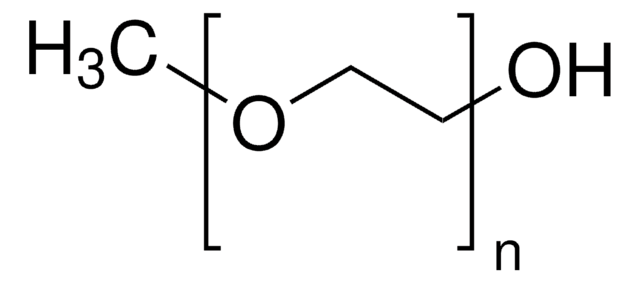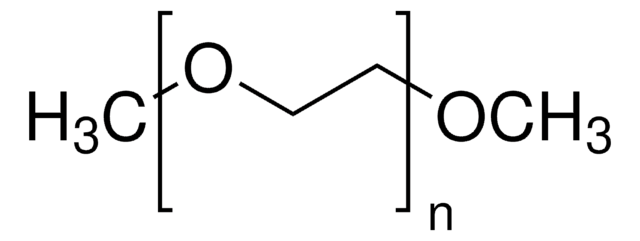71578
Poly(ethylene glycol) methyl ether
BioUltra, 500
Synonyme(s) :
Polyethylene glycol monomethyl ether
About This Item
Produits recommandés
Densité de vapeur
>1 (vs air)
Niveau de qualité
Pression de vapeur
0.05 mmHg ( 20 °C)
Description
non-ionic
Gamme de produits
BioUltra
Forme
paste
viscous liquid (clear)
Poids mol.
470-530
Impuretés
insoluble matters, passes filter test
≤0.005% peroxides (as H2O2)
pH
5.5-7.0 (25 °C, 50 mg/mL in H2O)
Pf
20 °C (lit.)
Solubilité
H2O: 50 mg/mL at 25 °C, clear, colorless
Traces d'anions
chloride (Cl-): ≤50 mg/kg
sulfate (SO42-): ≤50 mg/kg
Traces de cations
Al: ≤5 mg/kg
As: ≤0.1 mg/kg
Ba: ≤5 mg/kg
Bi: ≤5 mg/kg
Ca: ≤10 mg/kg
Cd: ≤5 mg/kg
Co: ≤5 mg/kg
Cr: ≤5 mg/kg
Cu: ≤5 mg/kg
Fe: ≤5 mg/kg
K: ≤200 mg/kg
Li: ≤5 mg/kg
Mg: ≤5 mg/kg
Mn: ≤5 mg/kg
Mo: ≤5 mg/kg
Na: ≤200 mg/kg
Ni: ≤5 mg/kg
Pb: ≤5 mg/kg
Sr: ≤5 mg/kg
Zn: ≤5 mg/kg
λ
50 mg/mL in H2O
Absorption UV
λ: 260 nm Amax: 0.06
λ: 280 nm Amax: 0.03
Groupe fonctionnel
hydroxyl
Chaîne SMILES
O(CCO)C
InChI
1S/C3H8O2/c1-5-3-2-4/h4H,2-3H2,1H3
Clé InChI
XNWFRZJHXBZDAG-UHFFFAOYSA-N
Vous recherchez des produits similaires ? Visite Guide de comparaison des produits
Code de la classe de stockage
10 - Combustible liquids
Classe de danger pour l'eau (WGK)
WGK 1
Point d'éclair (°F)
359.6 °F - closed cup
Point d'éclair (°C)
182 °C - closed cup
Équipement de protection individuelle
Eyeshields, Gloves
Faites votre choix parmi les versions les plus récentes :
Déjà en possession de ce produit ?
Retrouvez la documentation relative aux produits que vous avez récemment achetés dans la Bibliothèque de documents.
Les clients ont également consulté
Notre équipe de scientifiques dispose d'une expérience dans tous les secteurs de la recherche, notamment en sciences de la vie, science des matériaux, synthèse chimique, chromatographie, analyse et dans de nombreux autres domaines..
Contacter notre Service technique



